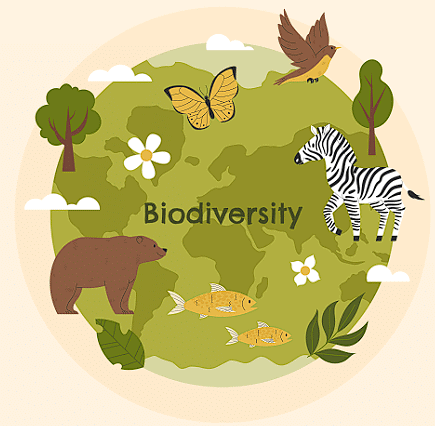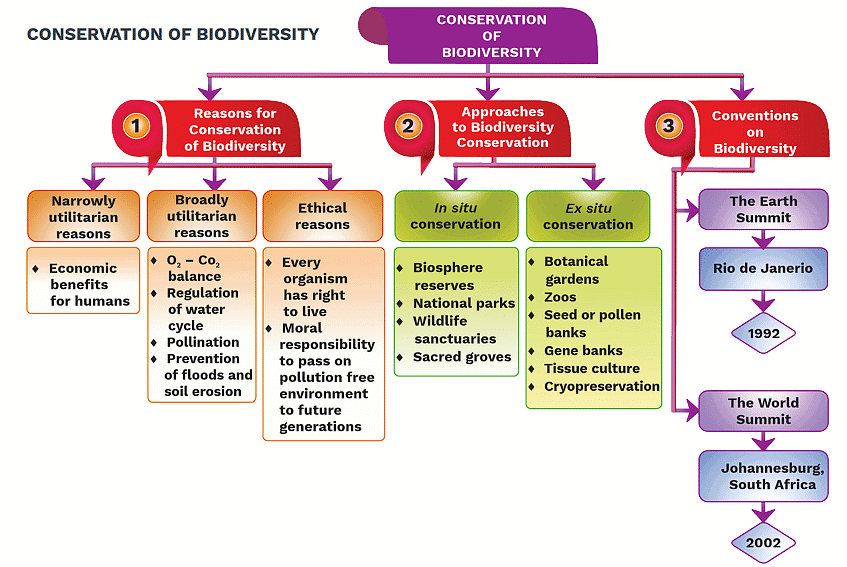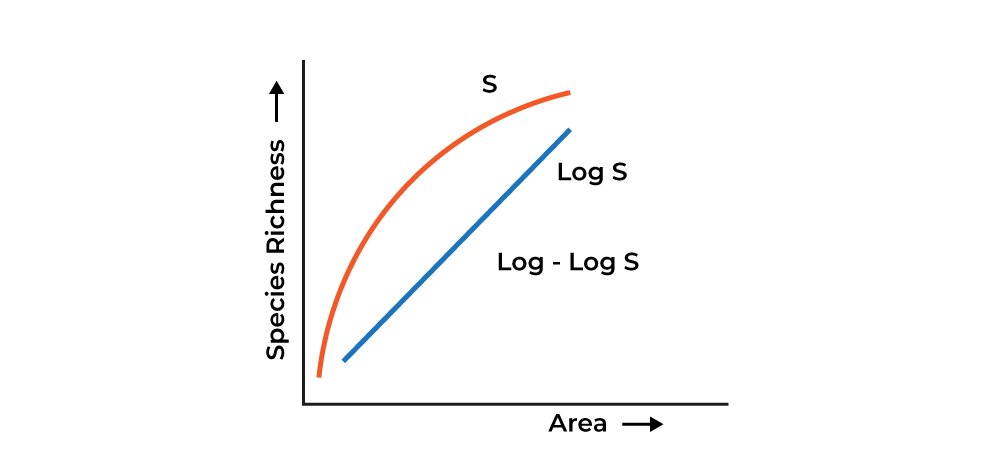Biodiversity and Conservation Chapter Notes - NEET PDF Download
What is Biodiversity?
The term "biodiversity" describes the abundance and diversity of life on Earth. It is one of the most complex and unique features of our planet, essential for the survival of all life forms. Coined in 1985 by scientist Edward Wilson, biodiversity encompasses the diversity at all levels of biological organization. Both natural and artificial ecosystems rely on biodiversity, which includes variability among plant, animal, and microorganism species, as well as the organization of organisms at different levels.

Biodiversity holds great ecological and economic significance. It sustains us by providing food, shelter, energy, clothing, and various other resources, while also contributing to economic benefits through activities like tourism. Therefore, understanding biodiversity is crucial for ensuring sustainable livelihoods.
Types of Biodiversity
There are three main types of biodiversity:
- Genetic Biodiversity
- Species Biodiversity
- Ecological Biodiversity
Question for Chapter Notes: Biodiversity and ConservationTry yourself: What does the term "biodiversity" refer to?
View Solution
Genetic Biodiversity
"A single species may exhibit high genetic biodiversity over its distributional range." Genetic biodiversity refers to variations in the genetic makeup of organisms within a species. Each individual within a species possesses a unique genetic constitution, leading to distinct characteristics. For instance, there are numerous genetic varieties within species such as rice, wheat, maize, and barley. India alone is home to over 50,000 genetically distinct strains of rice and around 1,000 unique mango varieties.
Species Diversity
- Species diversity refers to the variety of different types of species present in a specific region.
- It represents biodiversity at its most fundamental level, encompassing plants, animals, and microorganisms.
- No two individuals of the same species are exactly alike, showcasing biodiversity within species.
Ecological Biodiversity
- An ecosystem consists of living and non-living organisms interconnected with each other.
- Ecological biodiversity pertains to variations in plant and animal species that coexist in food chains and webs.
Importance of Biodiversity
1.Ecological Stability: Each species has a unique role in an ecosystem, contributing to energy collection, storage, and organic matter decomposition. Diverse ecosystems are more resilient to environmental stress and provide essential services for human survival.
2. Economic Importance: Biodiversity serves as a valuable resource for food production, cosmetics, and pharmaceuticals.
3.Ethical Importance: Every species has a right to exist, and humans should strive to prevent voluntary extinction. Biodiversity conservation safeguards diverse cultures, spiritual heritage, and the intrinsic value of every species.
How Many Species Are There On Earth And How Many In India
Life on Earth is characterized by its immense biodiversity, providing crucial ecosystem services such as food, medicine, and resources. The International Union for Conservation of Nature (IUCN) estimates that there are approximately 8.7 million species on our planet. However, only 1.2 million of these species have been formally described and categorized. Alarmingly, out of the described species, about 41,000 are currently facing the threat of extinction.

The breakdown of species across different groups is as follows:
- Invertebrates: This group comprises roughly 7.5 million species, encompassing various organisms like insects, mollusks, and sponges.
- Vertebrates: Approximately 66,000 species fall under this category, including mammals, birds, reptiles, amphibians, and fish.
- Plants: There are around 300,000 plant species, which include flowering plants, ferns, mosses, and gymnosperms.
Pattern of Biodiversity
Different types of patterns of biodiversity are:
Latitudinal Gradient
The latitudinal gradient pattern is the most easily understood and well-known method to study biodiversity. According to this pattern, biodiversity of species follows a predictable trend as we move from the equator towards the poles. Biodiversity is typically highest at the equator and decreases towards the poles. While there may be exceptions for certain species, this general trend is commonly observed. Ecologists propose the following reasons for the higher biodiversity in the tropics:
- Tropical regions have a more consistent climate compared to temperate regions. The stability of the tropical climate allows for a greater variety of species as they do not need to constantly adapt to changing seasons.
- The temperate zone has experienced several disturbances in the recent past, resulting in an unstable ecosystem. In contrast, the tropics have been relatively stable, leading to more frequent occurrences of specialization in tropical regions compared to temperate regions.
- Compared to other regions, tropical areas receive more solar energy. This results in plants in these regions obtaining more energy during photosynthesis, which in turn leads to higher energy levels in subsequent trophic levels of the food chain. This increased energy flow contributes to greater biodiversity.
Species-area Relationship
Alexander von Humboldt, a great German naturalist, and geographer, proposed a correlation between the species richness of an area and its geographic location. They found that the diversity of plants and animals increased as they expanded their observation area, but only up to a certain point. The relationship between species richness and area is represented mathematically as a rectangular hyperbola, and an equation can be used to describe it.
Alexander von Humboldt
log S = log C Z log A
- S = richness of species
- C = Y-intercept
- Z = regression coefficient
- A = Area

Importance of Species Diversity
- More diverse ecosystems are more productive. An ecosystem with a wide variety of producer species tends to have higher biomass, supporting a significant biodiversity of consumer species.
- An ecosystem is more stable and sustainable when it has a greater biodiversity of species.
- The more diverse the ecosystem, the better its ability to withstand environmental stresses like drought or invasive infections.
- An ecosystem's resilience in the face of disasters is enhanced by its species diversity. Communities with diverse species can utilize resources in varying proportions based on their needs. For example, plants with shallow roots access water and minerals in surface soil, while those with deep roots tap into nutrients from deeper soil layers.
- Rich biodiversity is crucial for ecosystem health and vital for the survival of humanity. Humans derive numerous products from nature such as fruits, grains, meat, wood, fiber, spices, dyes, medicines, antibiotics, and more. A high level of biodiversity facilitates complex interactions among organisms, such as those within food webs.
Loss of Biodiversity
- The decline in biological diversity globally is predominantly attributed to human activities such as overpopulation, urbanization, and industrialization.
- Human settlement on tropical Pacific islands has led to the extinction of over 2,000 native bird species.
- As per the IUCN Red List (2004), 784 species have vanished over the last 500 years, including 338 vertebrates, 359 invertebrates, and 87 plants.
- Recent extinctions include the dodo (Mauritius), Quagga (Africa), Thylacine (Australia), Steller’s sea cow (Russia), and three subspecies of the tiger (Bali, Javan, and Caspian).
- Within the past two decades, 27 species have ceased to exist.
- Currently, 12% of bird species, 23% of mammal species, 32% of amphibian species, and 31% of gymnosperm species worldwide are under the threat of extinction.
- Amphibians are particularly vulnerable to extinction based on the available data, with around 15,500 species globally facing the risk of disappearing.
Causes of Biodiversity Losses
(a) Habitat Loss and Fragmentation
Habitat loss and fragmentation, caused by pollution, urbanization, and other human activities, are major factors leading to the extinction of species and loss of biodiversity. For example, the Amazon rainforest, home to countless species, is rapidly disappearing due to deforestation. The fragmentation of habitats into smaller areas due to human activities greatly impacts mammals, birds, and migratory species that require large territories.
(b) Over-Exploitation
Over-exploitation of natural resources results in the extinction of various species. Humans excessively use biological systems to extract resources, leading to resource depletion and species extinction. Historical examples of over-exploitation include the Steller’s sea cow, the passenger pigeon, and numerous marine fish species.
(c) Alien Species Invasions
Introduction of alien species, whether intentional or accidental, can result in invasive species that drive indigenous species to extinction. An infamous case is the introduction of the Nile perch in Lake Victoria, which led to the extinction of over 200 species of cichlid fish in East Africa. Unauthorized imports of species like the African catfish also threaten indigenous fish populations.
(d) Co-extinctions
Co-extinction occurs when the extinction of one species triggers the extinction of species dependent on it. For instance, a parasite may go extinct if its host species disappears. This interconnectedness underscores the delicate balance of ecosystems and the ripple effects of species loss.
To effectively summarize and synthesize the provided information into HTML-formatted educational content, we will structure the key points under each heading and subheading using appropriate HTML tags. The content will be organized, visually appealing, and easy to comprehend for educational purposes.
Why Should We Conserve Biodiversity?
(a) Narrowly Utilitarian
One primary reason for conserving biodiversity is its narrowly utilitarian value. Human societies directly benefit economically from nature through various resources like food, firewood, fibers, and industrial products. For instance, a significant percentage of global drugs are derived from plants, emphasizing the importance of preserving biodiversity for medicinal purposes.
(b) Broadly Utilitarian
Another important aspect is the broadly utilitarian value of biodiversity. Ecosystem services provided by nature, such as oxygen production by forests, are essential for the well-being of the planet. For example, the Amazon rainforest alone contributes significantly to the Earth's oxygen supply through photosynthesis.
(c) Ethical
Finally, there is an ethical imperative to conserve biodiversity. It is our moral responsibility to protect other species due to their intrinsic value. Ensuring that future generations can inherit a healthy biological heritage is a fundamental ethical consideration.
Conservation of Species Diversity
Every species plays a crucial role within an ecosystem, highlighting the significance of biodiversity preservation. If a species becomes extinct, various methods can be employed to safeguard biodiversity.
- In-situ conservation: This method involves safeguarding biodiversity-rich regions such as biosphere reserves, national parks, and sanctuaries. For instance, the Sunderbans are protected to conserve several endangered species like the royal Bengal tiger, olive ridley sea turtles, and various mangrove species.
- Ex-situ conservation: In this approach, endangered and threatened species are identified, relocated, and preserved in designated areas like botanical gardens and wildlife safaris, providing them with comprehensive protection.
Q1: What is biodiversity and why it's necessary?
- Biodiversity refers to the variety of organisms such as plants, animals, insects, and microorganisms that inhabit the Earth. These organisms coexist in ecosystems, working together to sustain life on our planet.
Q2: How many types of biodiversity exist on our planet?
- There are three main types of biodiversity: genetic diversity, species diversity, and ecosystem diversity.
Q3: What is the definition of species diversity?
- Species diversity refers to the number of species and the abundance of each species within a specific area or ecosystem.




















